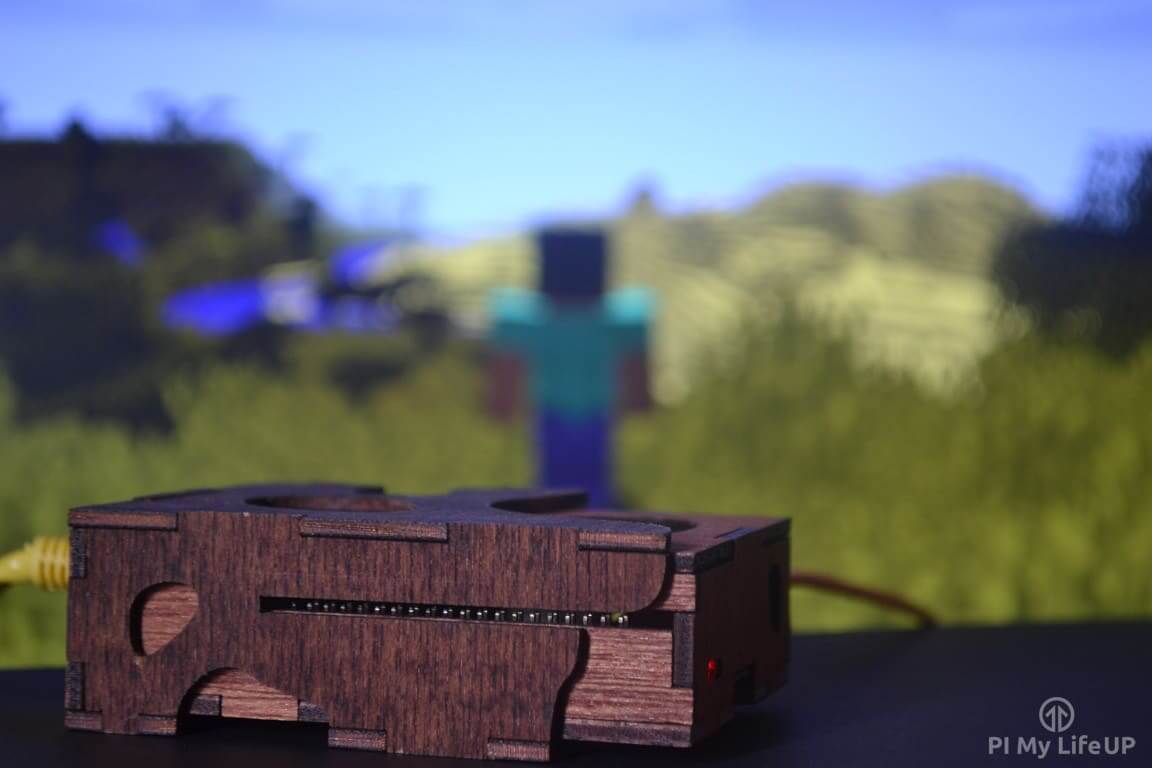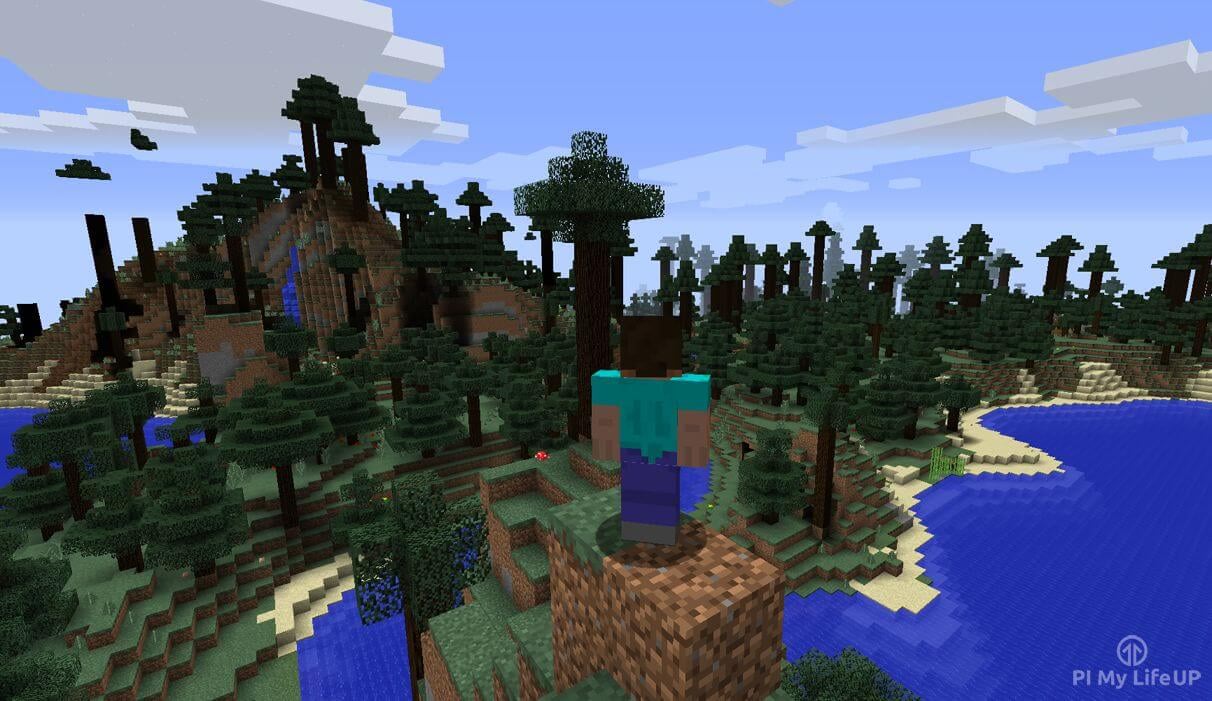A Raspberry Pi Minecraft server is a cost-effective way to have your very own private server with your friends or just for stuffing around on.

I have had mine running for quite some time now and haven’t come across too many problems. It is very important to know that this server will not be able to hold many people.
From my experience, anything over five people and the server will start to get a bit wonky. I found the optimal amount of people is only two to three, but this can be improved upon by tweaking the server.
We are also going to be using the spigot version of Minecraft as the default install didn’t work for me. I found that it will crash a lot, be laggy, and is very unstable. The official Java version may improve over time.
If you are looking for the Bedrock server, be sure to check out our Minecraft Bedrock server tutorial. It will take you through all the steps to setting it up correctly.
In this project, we will utilize Java, which should already be installed on Raspberry Pi OS. We will make a few changes to optimize the server for the Raspberry Pi 2, 3, 4, or 5. We will also set it up so you can access it on the web, and have it reboot if the Pi goes offline for any reason.
Equipment
Please find the equipment that I used for making this Raspberry Pi Minecraft server below.
Recommended
- Raspberry Pi Amazon
- Micro SD Card Amazon
- Ethernet Cable Amazon or Wi-Fi Amazon (I recommend using an ethernet for the best network performance)
- Power Supply Amazon
- USB Keyboard Amazon
- USB Mouse Amazon
Optional
Video Tutorial
If you want to see how to set up the server, then check out my video below. Otherwise, I have a detailed text explanation immediately below the video.
If you like the video, please make sure you subscribe or follow us on social media, so you are kept up to date.
Setting up the Raspberry Pi Minecraft Server
Firstly, we must install an operating system onto the Raspberry Pi. If you haven’t already done this, check out our awesome guide on installing Raspberry Pi OS. It will take you through all the steps that you will need to do.
In this tutorial, we will work entirely in the terminal. It is probably best we boot straight into the terminal so we can save on resources by not loading the GUI.
1. First, update operating system packages to the latest version by entering the following commands.
sudo apt update
sudo apt upgradeCopy2. Now, we will need to make a couple of changes in the config tool. Let’s bring the tool up by entering the following line.
sudo raspi-configCopyIf you need more information regarding the raspi-config tool, please check out our guide.
3. Also, it is unlikely you want to boot into the desktop, so ensure the boot option is set to the CLI (Command Line Interface). This change will help give the server as much processing power as possible.
To change the boot option, select 1 System Options, and select Boot / Auto Login.
Select Console or Console Autologin.
4. Finally, enable SSH so we can access the Pi remotely if required, unless you already have it enabled.
To enable SSH, go to Interface Options. Next, Select I1 SSH. Lastly, answer <YES> to enable the SSH server.
5. Now go to <Finish> on the main screen and answer <YES> to the reboot question.
6. We will now want the IP address of our Pi for when we try to connect to our server. To get the Raspberry Pi IP address, enter the hostname command.
sudo hostname -ICopyTo ensure the IP doesn’t change, you should set up setup a static IP address on the Raspberry Pi and your router.
7. Next, we need to make sure that Git and jq is installed. Otherwise, we will not be able to build the server.
Enter the following command to install the Git software as well as jq. jq allows us to easily interpret JSON data within the terminal.
sudo apt install git jqCopy8. By default, Java (17) should already be available on Raspberry Pi OS (Bookworm). However, if you wish to use the latest version of the Minecraft server, you will need to use a newer version than what is available.
To install a version of Java compatible with Minecraft 1.20.6 + (Java 21 or 22), please follow our installing Java guide.
9. Now, we will need the Minecraft server file, which we will create using a builder tool that Spigot supplies.
To get the tools, enter the following commands.
mkdir ~/minecraft
cd ~/minecraft
wget https://hub.spigotmc.org/jenkins/job/BuildTools/lastSuccessfulBuild/artifact/target/BuildTools.jarCopy10. Now we will want to run the build tools file, so it creates our Spigot server. It will take about 15 minutes to finish.
Change --rev latest at the end of the command to get a different version. Don’t forget to change latest in the command to the version number you wish to download. For example, --rev 1.20.6 will download version 1.20.6.
java -Xmx1024M -jar BuildTools.jar --final-name server.jar --rev latestCopyImportant: If you have a Raspberry Pi B+, B, or any variation before the Raspberry Pi 2, the build tools will likely fail. You will need to generate the spigot.jar on a more powerful computer instead.
11. To ensure the Spigot server successfully downloaded and saved, simply type ls. You should see spigot-1.20.6.jar. The filename may be different depending on the version you downloaded.
lsCopyMake sure you remain in the ~/minecraft folder as we want all the server files to be created in here. If you start the server in a different folder, it will create the files there.
12. Now we are ready to launch the server. To do this, enter the following command. You may need to change the version number depending on what version you’re using e.g. spigot-1.20.6.jar.
Raspberry Pi 1
java -Xms256M -Xmx496M -jar ~/minecraft/server.jar noguiCopyRaspberry Pi 2, 3, 4, or 5
java -Xms512M -Xmx1008M -jar ~/minecraft/server.jar noguiCopyWith the 2GB and 4GB variants of the Raspberry Pi 4 or 5, you can increase the Xmx value even higher.
The server will stop straight away as we will need to agree to the Eula. You can do this by opening the Eula by typing the following command.
nano eula.txtCopy13. In here, change “false” to “TRUE“. Once done, save and exit by pressing CTRL + X, then Y.
14. Now relaunch the server. It will take a while to create a map, so give it about three to five minutes. If you ever reboot again, it will only take thirty seconds to load if the map has already been created.
15. The server should be running and accessible over the local network.
16. You might want to mod your user now so that you can use all the server commands when you log in. If we have it auto-boot on startup, accessing the server backend is slightly more difficult.
To mod your user, simply run the following command when the server has launched (Replacing username with your username).
op username17. The Minecraft server on the Raspberry Pi will now be up and running fine, but you may want to do some optimizations to the server to make it run even better.

Connecting to the Minecraft Server
If you are on a local network, it should be pretty easy to connect to the Minecraft server running on the Raspberry Pi. To test it out, follow the steps below.
1. Load the Minecraft Java client on a computer within the same local network as the Pi. Ensure the version of the client matches the version of the server.
2. Go to multiplayer, and your server might appear in the local list. If it doesn’t, simply go to direct connect and enter the IP address we got earlier on the Pi using the hostname command.
hostname -ICopy3. If you want to allow access to the Minecraft server via the internet, you will need to set up port forwarding.
Assuming you want to learn how to do this, head over to my guide on setting up Raspberry Pi port forwarding. You will need to port forward the port 25565 (unless you change it in the server properties) to the IP of your Pi.
Configuring the Server
Here are a few tips for configuring the server and getting it up and running.
Optimizing the Minecraft Server
To get the most out of our Minecraft server on the Raspberry Pi, you can install a plugin to help optimize the performance.
There are many plugins that can help with performance or extend the server’s functionality. Simply use the wget command to download them to the Pi. Below is an example.
cd ~/minecraft/plugins
wget -O example.jar <example_plugin_url>CopyEditing the Minecraft Properties
You will probably want to know how to edit the server properties. This ability to edit is very important for optimizing the server and customizing it to how you want the server to be.
If you want more information for each of the server settings, you can find a good page on all the server properties here.
To enter the server properties, enter the following line.
sudo nano ~/minecraft/server.propertiesCopyNow, we will want to change a few settings to help optimize the performance of the server.
You can change these and other settings to whatever you like however you want, but keep in mind the Pi can’t handle too much processing.
view-distance=04
max-player=5CopyBoot on Startup
To have the server start on boot, we will need to do a few extra steps.
1. We will need to create a service for the Minecraft server so let’s start writing the service file by entering the command below.
sudo nano /lib/systemd/system/minecraftserver.serviceCopy2. In this file you will need to enter the following text.
This file defines the service, so the service manager knows how and what to run. Don’t forget to update the spigot version number whenever you upgrade.
Update “<USER>” with the username you plan on using to run the server. You can see the username of your user by entering the whoami command into the terminal.
[Unit]
Description=Minecraft Spigot Server
[Service]
User=<USER>
Group=<USER>
Restart=on-abort
WorkingDirectory=/home/<USER>/minecraft/
ExecStart=/usr/bin/java -Xms512M -Xmx1008M -jar /home/<USER>/minecraft/server.jar nogui
[Install]
WantedBy=multi-user.targetCopyOnce done, save the file by pressing CTRL + X then Y followed by ENTER.
3. Now, we will need to enable the service. You can enable the service by running the command below.
sudo systemctl enable minecraftserver.serviceCopy4. You should now be able to start the Minecraft server by simply using the following command.
sudo systemctl start minecraftserver.service5. Using a similar command, you can check on the status of the service. Checking the status is great for debugging.
sudo systemctl status minecraftserver.serviceCopy5. You can stop the server by using the following command.
sudo systemctl stop minecraftserver.serviceCopyYour server should now start on boot. You can test it by restarting the Raspberry Pi. It will take a few minutes to startup.
sudo rebootCopyIf you want to get access to the server on the command line, then you will need to shut down the server and load it using the normal command.
Updating your Minecraft Server on the Raspberry Pi
In this section, we will be showing you how to update to the latest version of the Minecraft server on your Raspberry Pi.
1. Before we can begin to update the Minecraft server, we will need to change to the directory where the server is stored.
If you have followed our tutorial, this means you should be able to change to the correct place by running the command below.
cd ~/minecraft/Copy2. The first thing we will want to do now that we are in the right place is ensure we have the latest version of the Spigot build tools.
We can use the wget command to download the latest release by using the following in the terminal.
wget https://hub.spigotmc.org/jenkins/job/BuildTools/lastSuccessfulBuild/artifact/target/BuildTools.jarCopy3. With the build tools updated, we can now grab the version number for the latest version of the Minecraft server by using the following command.
If you have a particular version of the Minecraft server, you want to use on your Raspberry Pi replace the command with that here. Otherwise, we can use a bit of curl and jq magic to get the version number we are after.
MINECRAFT_VERSION=$(curl -sS https://launchermeta.mojang.com/mc/game/version_manifest.json | jq -r '{latest: .latest.release} | .[]')Copy4. Once you have got your version number saved to the environment variable we can proceed.
Before we can update the Minecraft server on our Raspberry Pi, we will need to stop the current one from running. You can stop the running server by running the command below.
sudo systemctl stop minecraftserverCopy5. Now use the Spigot build tools to download and update you Minecraft server to the latest version.
Please note that this process can take a couple of minutes to complete.
java -Xmx1024M -jar BuildTools.jar --final-name server.jar --rev $MINECRAFT_VERSIONCopy6. Once the update process completes, you can start the server up by using the following command.
sudo systemctl start minecraftserverCopyConclusion
I hope this tutorial has helped you in setting up a stable version of a Raspberry Pi Minecraft server. If you like this tutorial, then be sure to check out our many other Raspberry Pi Projects.
Also, feel free to drop us a comment below if you have better optimization settings, plugins, or ideas. If you’re having trouble, let us know below.










Im trying to install some plugins onto the server but i cannot seem to get them to show up and work could you help me out?
Can you please let me know which plugins and I will try on my local copy.
How do you re-generate the map because it is a horrid map it generated so i want a new one also i can’t do any commands on the server when i am playeing even if i op myself.
Go into your server.properties file and change the level-name.
Eg. Change it from:
level-name=world
to
level-name=world2
Once done, reboot the server.
Commands are working just fine on my local copy. Does it spit out any errors ?
it’s all fine now the commands were not working for about a week now its fine.
Thanks this is an amazing tutorial!
How do you make one open to the whole world or in one country?
Opening the server up to the world, you will need to setup port forwarding.
also how do i do commands in game because it says i don’t have permission to do commands? and i can’t do commands for the server in ssh or on the pi itself?
Hello (:
I have a question about the server, when we’re more than 1 on the server at a time, someone is disconnected. it says time out, connection lost.
Does someone know what is wrong? I am using spigot version 1.11.2
pi@raspberrypi:/home/minecraft $ ./BuildTools.jar –rev 1.11
-bash: ./BuildTools.jar: Permission denied
HELP WHAT TO DO??
Run as root eg.
sudo java -jar ./BuildTools.jarHello, the tutorial worked great! I was wondering how you update your server but keep the same world. I really want to update my server to 1.11 but I don’t want to lose my 1.10 world.
How do I stop the “boot on startup” option? I need to check my ip address and I can’t get to the GUI.
sudo hostname -I
Server is working great now for a few weeks. Just a question I need to set someone op on the server. How do I go about that? I know the commands /op name (or fist three of four letters of the name + tab) /deop name removes it again. But thats in game and if you have op yourself. I’m talking about on the pi. How do I do it if I ssh into the pi again. Can someone please give clear instructions on how to do this. I need to set myself as op so I can change some gamerules.
Hi, just tried this out and everything seemed fine until I got to using the buildtool. When I ran sudo java -jar Buildtools.jar, it told me java wasnt a valid command. I tried using the full path name and got this error:
Loading BuildTools version: git-BuildTools-4bf25ea-55 (#55)Git name not set, setting it to default value.
Exception in thread "main" java.io.IOException: Cannot run program "git" (in directory "."): error=2, No such file or directory
at java.lang.ProcessBuilder.start(ProcessBuilder.java:1048)
at org.spigotmc.builder.Builder.runProcess(Builder.java:543)
at org.spigotmc.builder.Builder.main(Builder.java:166)
Caused by: java.io.IOException: error=2, No such file or directory
at java.lang.UNIXProcess.forkAndExec(Native Method)
at java.lang.UNIXProcess.(UNIXProcess.java:248)
at java.lang.ProcessImpl.start(ProcessImpl.java:134)
at java.lang.ProcessBuilder.start(ProcessBuilder.java:1029)
... 2 more
Its like it doesnt recognize java
same here. did you ever get a resolution?
Hi,
Is there a way to gracefully shutdown the minecraft server? I am thinking I should create a minecraft-shutdown.sh file, but I have no idea what command line I need to shut it down.
Thanks
-Ben
so any idea on how to set someone as op on the server?
In the server type /op [name of the player] when that player is online.
or try /op 1st letters of the player and pres tab to autofill the name
yea not working when your not op. I’m talking about from the raspberry pi itself. I know all the commands on minecraft but you need to be op already unless im missing something.
hi Gus,
excellent tutorial! i was able to have it running on my Pi3 but I’m having problems connecting with the Pocket Edition. i have two tablets with the pocket edition and when running minecraft on one of them I can see the other and so I can connect to the world. However, both android tablets can’t find the minecraft serve on the Pi. I’ve already tried manually configuring the IP but nothing connects… Could it be a limitation of pocket edition version? I don’t have the PC version, so I cannot check if the PC version is able to see the PI3 server…
Hi Nuno, Yes that’s correct, I believe the pocket edition can’t connect to a normal or spigot version of the server. It is on my “to do list” to look into a pocket edition server for the Pi.
Hello great server,but it`s just don`t stopping with nothing,and it does not accept any kill command to stop or any other command at all,Does anyone knows how to fix this?
I am getting sudo: /opt/jdk11.8.0_60/bin/java: command not found when i try to run server and if i delete the line and run the code again i get sudo: invalid option — ‘X’ what does this mean? I am using a raspberry pi 3 with the newest os and I am try to run minecraft 1.10.
Try running
sudo java -Xms512M -Xmx1008M -jar /home/minecraft/spigot-1.10.jar noguiHey Gus, is there any way to run a Minecraft PE server on the raspberry Pi? If there is, I would love some of your awesome instructions!. Thanks!
Hi Jason, I am not 100% sure, ill need too look into it! I have added it to my list of things to do 😀
Hi: the post “Raspberry Pi OwnCloud: Your Own Personal Cloud Storage” is offline, is it possible to fix it? Thanks!
Ronnie
Should be fixed now, not sure what happened there.
Awesome tutorial – just got it going on my Raspberry Pi 2. Is there way to change the server settings to allow users from the same account on the local LAN (different PC’s) to play at the same time?
Is there someone that gets a spigot version of 1.10.2 running on the Raspberry pi?
I keep getting errors 🙁 and nothing seems to work it
This is the error message i get …
"Rebuilding Forked projects....
fatal: '/home/MC-creative/Bukkit' does not appear to be a git repository
fatal: Could not read from remote repository." {Edited}
hey my other server compiled a working 1.10.2.jar owkay. strange
but here it is
https://berendjan.stackstorage.com/index.php/s/ylBRiVXs9s0889a
Never mind, my other Pi3 just spit out a working 1.10.2 so i copy that one over…
Just purchased a Pi 3 and going to attempt to build this for my 6yr old son and his friends.
Question. Can I run both the server and the client on the same Pi? the reason I asked is to decide if I need to buy him a computer, chromebook or another Pi so he can play.
I would like to save $$ and just run both server and client on the same Pi if possible… can you answer my question? Thank You!!!!
Minecraft for PI isn’t that feature complete. The PI 2/3 can run a small server. But since full Minecraft is Java you need a real desktop to nun it.
Heads up that if you’re using Raspian Jesse, don’t bother with the OpenJDK Java that comes with the distro. Nothing but pain. Follow Gus’s guide and install the Oracle Java even though it says you don’t need to. Oracle Java is better anyway and will be more performant.